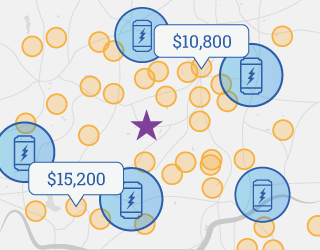Battery storage is becoming increasingly popular throughout the US. This is particularly true in parts of the country that are impacted by frequent electrical outages, whether due to natural disasters or otherwise. A big reason why storage is popular in these areas is due to storage’s ability to “island”.
What is islanding?
Unfortunately, islanding does not mean that installing an energy storage system on your property will turn your home or business into a Caribbean island. However, much the way that islands are forced to be self-sufficient, if you install a battery with islanding capabilities, you will be able to turn your home into an “energy island”. As a result, islanding allows you to keep your home powered regardless of what’s occurring on the rest of the grid, including during weather-related outages.
Importantly, islanding does not mean that your home has gone off-grid: in almost all scenarios, your home will remain connected to the rest of the electrical grid even after installing solar and storage on your property. This allows you to reap the benefits of net metering policies, as well as to continue to be able to pull from the grid at night when your solar panels aren’t producing.
However, if you’re interested in investing in solar or solar plus storage because you want to be able to continue to power your home even in the event of a grid outage, you’ll need to make sure that the battery you are installing has islanding capabilities.
Solar panel systems don’t automatically island
A common misconception about solar panel systems is that they automatically continue to produce electricity if the grid goes down, so long as the sun is shining. In fact, all inverters are required to be able to “anti-island”. In other words, solar inverters are explicitly designed to not allow your solar panels to continue to push electricity into your home in the event of an outage.
This occurs primarily for the safety of utility line workers that are tasked with responding to an outage and getting the electrical system back up and running smoothly. When your solar panels are producing electricity, they’re not just sending electricity into your home – they also send excess electricity to the grid. This creates a dangerous situation for line workers, whose job it is to work with transmission and distribution lines during an outage. If they begin working to restore the electrical grid thinking that there’s no electricity flowing through the wires, but solar panel systems in the area are still pushing electricity onto the grid, the results could be catastrophic.
Islanding, on the other hand, allows for the best of both worlds. On the one hand, it allows you to continue to power your home with locally produced solar generation even in the event of a grid outage. On the other hand, a system that is islanded has no risk of pushing excess electricity onto the grid, making it safe for utility workers to work to restore regular service.
Use cases for islanding
There are many reasons why having a solar plus storage system with islanding capability may make sense for your needs. For one, if you live in an area where electrical service is frequently interrupted–whether due to hurricanes, wildfires, or even ice storms leading to downed lines–having a storage system for backup power and the ability to continue to refill the battery with electricity from your solar panel system for power can be a lifesaver. This is especially true for anyone who needs to keep medication refrigerated or medical devices plugged in or for hunters or others with large freezers full of pricey or priceless goods.
Regardless of whether you need to have the electricity on in your home for health or other reasons, it is objectively nice to be able to keep the lights (and AC or heat) on when the rest of the grid goes dark.
Where to find solar batteries
If you’re researching solar batteries, we at EnergySage recently released the solar Buyer’s Guide, a one-stop resource for all solar equipment currently available. Check out the Solar Batteries section to evaluate and compare different technology options. Once you’ve found the solar battery you’d like to install on your property, register for the EnergySage Marketplace and indicate which battery you’d like to be quoted.






